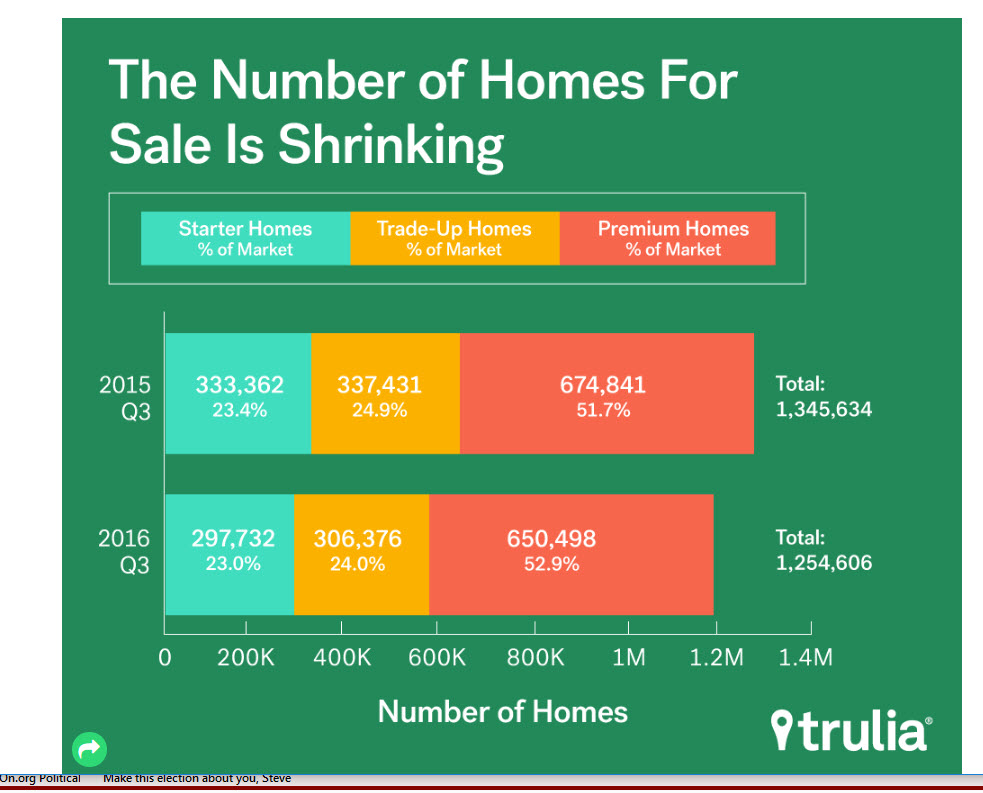
August brought even worse news for first-time and move-up buyer as chronic inventory shortages grow even, inflating home prices even more. A double whammy of unaffordable prices and shrinking selections of homes for sale continue to handcuff the housing recovery.
“Hopes of a meaningful sales breakthrough as a result of this summer’s historically low mortgage rates failed to materialize because supply and affordability restrictions continue to keep too many would-be buyers on the sidelines,” said NAR’s Lawrence Yun, with the release of August’s existing sales report.
Once again, sales were down despite mortgage rates near record lows as higher home prices and not enough inventory for sale kept some would-be buyers at bay. Total existing-home sales declined 0.9 percent to a seasonally adjusted annual rate of 5.33 million in August from a downwardly revised 5.38 million in July. After last month’s decline, sales are at their second-lowest pace of 2016, but are still slightly higher (0.8 percent) than a year ago (5.29 million), NAR said.
“Hopes of a meaningful sales breakthrough as a result of this summer’s historically low mortgage rates failed to materialize because supply and affordability restrictions continue to keep too many would-be buyers on the sidelines,” said Yun.
At the heart of the crisis is an inventory shortage now declining for a fifth straight quarter, the longest streak since the housing markets bottomed out in 2012, reported Trulia today. Starter and trade-up buyers are suffering more than premium buyers from price increases stimulated by shortages of homes for sale. Trulia economist Ralph McLaughlin reported that:
- Numbers of both starter and trade-up home are declining are double digit rates while inventory for premium homes is down only 3.2 percent;
- Starter and trade-up buyers spend 1.7 to 0.9 percent more of their income to buy a home today than they did at this time last year. Premium buyers must shell out only 0.6 percent more of their income.
- The number of starter homes dropped 10.7 percent this year; and
- Numbers of trade-up homes fell 9.2 percent.
McLaughlin sees hope in inventory increases reported in cities like San Francisco and Miami, the fourth straight quarterly gain for San Francisco and the second straight for Miami. In both markets shortages have been acute, outpacing national norms. Trulia published a list of 21 markets where inventory increased on an annual basis, but many of the markets on the list also registered hikes exceeded national norms, motivating owners to cash in.
NAR reported that at the end of August total housing inventory fell 3.3 percent to 2.04 million existing homes available for sale, and is now 10.1 percent lower than a year ago (2.27 million) and has declined year-over-year for 15 straight months. Unsold inventory is at a 4.6-month supply at the current sales pace, which is down from 4.7 months in July.
Inventory data from Realtor.com® reveals that the metropolitan statistical areas where listings stayed on the market the shortest amount of time in August were three markets where Trulia said inventory was improving: San Francisco-Oakland-Hayward, Calif., San Jose-Sunnyvale-Santa Clara, Calif., and Denver-Aurora-Lakewood, Colo.
NAR President Tom Salomone, broker-owner of Real Estate II Inc. in Coral Springs, Florida, says in today’s fast-moving market, a Realtor® who knows about down payment options4 and their target area is essential to a successful buying experience. “Given the inventory shortages in most markets, new listings at affordable prices are receiving multiple offers and going under contract almost immediately upon becoming available,” he said. “Home shoppers serious about buying need to be ready with a pre-approval. This allows a Realtor® to hone in only on homes within the buyer’s price range and ensures any offer presented to the seller is taken seriously.”
Source: Trulia







